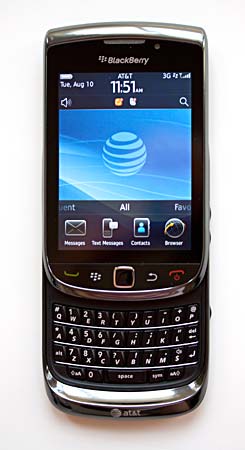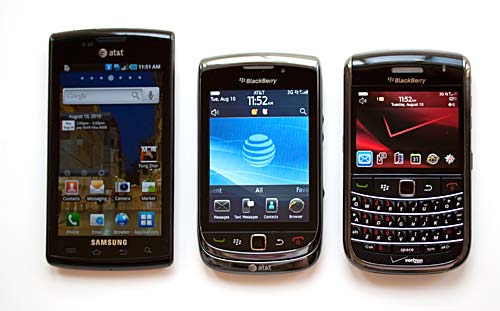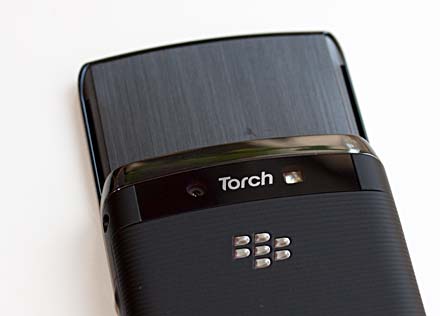In addition to the cushy leather seats and Alcantara headliner, the rear compartment is stocked with two Apple iPads, two seat-mounted multimedia screens, a 64GB iPod Touch and a 15.2-inch headliner-mounted Mac display. Not only can these products be used for personal use, but the two iPads also control the car’s Command system, encompassing the radio, navigation and telephone systems. The whole Apple setup is powered by an ultra-small Mac Mini in the trunk that is housed in an electronically deployed drawer.
Saturday, August 28, 2010
Brabus iBusiness Luxury Sedan
Mixing fast luxury sedans with Apple iPads and Macintoshes? What else could you ask for?
Thursday, August 26, 2010
5 Things I Like About the BlackBerry Torch 9800 - And a Few I Don't
Via www.PCMag.com
- Is the Blackberry Torch better than an iPhone? No, but here are some of the reasons why it's good enough for me.
Research in Motion surprised me a week or so ago when it sent aBlackberry Torch review unit. Apparently, the company sent out a lot of them. It seems as if the folks at RIM are more than a little nervous about the market reception to this phone and its overall chances for success. I don't blame them. This polarizing product has reviews that are largely complimentary and others that are already calling the Blackberry Torch 9800 underwhelming or worse.
Its early sales—150K in the first weekend—are nowhere near Apple iPhone sales numbers, but they're still respectable.
Last week, I got into an argument about the BlackBerry Torch with a Gizmodo editor. This guy is probably 20 years younger than me and can only view the Torch through the prism of an Apple iPhone. The technology is old he told me and the screen resolution, in today's 800-by-480 world, is embarrassing. I'd already been carrying the Torch around for a few days, and I simply couldn't agree with him.
I won't argue the fact that the iPhone 4 is an excellent product. And the slew of Android phones, with and without keyboards, are exciting products. I like the Droid X, for instance, though I think it's too big to carry around on a day-to-day basis. I like the original Droid and Droid 2, though I think Motorola still has some work to do on that keyboard.
The keyboard—really any mobile phone keyboard—is, to a certain extent, at the crux of my disagreement with the Gizmodo editor. He, like many other early 20-somethings, is perfectly comfortable without a physical keyboard. I'm not. There are many people in my generation just like me and probably many existing RIM customers who still prefer QWERTY phones.
But leaving aside the yawning generational differences, I like the Torch and I enjoy using it. Not only do I not miss my BlackBerry Bold 9000, I don't want it back. Here's why:
1) The Browser: Yes, this is mostly a credit to the BlackBerry OS 6, but without a touch screen and accelerometer, which lets me switch from portrait to landscape mode, the experience wouldn't be half as good. It's definitely faster, handles virtually any kind of Web site, and is backed by a screen that, while not as high res as a Droid or iPhone, is easily sharp enough for my eyes.
2) The Home Screen: RIM has done a nice job with the available real estate on the Torch screen, and I love how the screen moves left to right and up and down. I can live in the All screen, but now, as with other configurable mobile platforms, I can customize it as well. There are quite a few icons on the All screen, so being able to move some to Favorites is a welcome change. I'm also glad the Text message icon is now at the top of the list. On my Bold, I often missed text messages because the icon was stuffed well below the digital fold. In addition, I like that some of the important apps, like Twitter, are now a default part of the system.
3) The Touch Screen: I used to own a Palm Treo and always appreciated the combination of touch and physical typing. Granted, that old Palm screen was very limited. The Torch, on the other hand, is not. I like that I can use gestures to move through the various screens. The addition of the pinch and zoom is welcome, though, I can't imagine someone launching a touch screen without it.
4) The Design: The Torch is heavier than my Bold, but it feels very good in my hand. The lines are nice, though not revolutionary. There is something very BlackBerry-ish about the Torch—and I'm fine with that.
5) The Keyboard and Touchpad: Yes, the keyboard is smaller and a tad more cramped than my Bold, but RIM has given the keys slightly shaped edges, so they're easier to feel. I can still do some typing without staring at the keys. If I type on an iPhone, I have to watch my strokes (don't hate me because I'm old). Anyone who has an older Curve or first-generation Bold will appreciate the trackpad. However, the reason it's interesting on the Torch is because it lives right below a full touch screen. At first I wondered why you would need the trackpad with the gesture-driven screen. However, I soon became adept at using it for one very critically feature—something that isn't so easy to do on an iPhone: moving a cursor around through letters, words, and blocks of text.
On an iPhone, I place my finger where I want to select and hold it until the cursor moves to that spot. If I hold for a second longer, my selection tools appear. There is no easy way to scroll through text. The Torch's trackpad lets me move my cursor anywhere I want—in interfaces and text—and then start selecting, copying, pasting, etc. It's a subtle difference but one that's important for a certain kind of user.
By Ray Nicolini
Wednesday, August 25, 2010
FCC approves KeyCase iPad Folio with built-in Bluetooth keyboard

The iPad isn’t a netbook, but it’s really starting to bite into some of those netbook sales. With the recent FCC approval of the KeyCase iPad Folio, we could see even more of a push in this area. That’s because this particular iPad case happens to pack a QWERTY-flavored punch.
Rather than simply protecting the Apple iPad from the random bump and bruise, the KeyCase iPad Folio takes it one step further by adding a.. you guessed it, a Bluetooth keyboard into the mix. This keyboard can easily slip into the case, propping up the iPad in the process, and effectively giving you an experience closely mirroring that of a netbook.
I’d imagine the Bluetooth connection would pull something away from the iPad’s battery life, but that’s a small price to pay to get whacking some physical keys again. To go back to being as mobile as possible, the Bluetooth keyboard can be totally removed too. Neither the manufacturers nor the FCC have any indication as to a release date or price, but GearZap of the UK is listing the KeyCase iPad Folio for £59.95 (about $90 USD).
Bluetooth iPad keyboard case crosses FCC [Updated] [Slashgear]
KeyCase iPad Folio with Integrated Bluetooth Keyboard – Black [GearZap]
KeyCase iPad Folio packs a Bluetooth keyboard, scores FCC approval [Engadget]
KeyCase iPad Folio with Integrated Bluetooth Keyboard – Black [GearZap]
KeyCase iPad Folio packs a Bluetooth keyboard, scores FCC approval [Engadget]
via www.mobilemag.com
Saturday, August 21, 2010
9 Humiliating Ways People get Injured Using a Cell Phone
Despite their usefulness, cellular phones get a lot of negative press. Excessive and improper cell phone use accounts for hundreds of thousands of injuries and deaths around the world every year. A recent study showed that a coordinated 20 year-old on a cell phone has the same reaction time as that of a 70 year old. This waned concentration can lead to many dangerous situations. And while most of us have made it this far without the need of protective shoulder pads or helmets, the risk of cell phone injury still exists. The following is a list of cell phone injuries, ordered in their likeliness to occur, from most to least.
1. Bumping Into Inanimate Objects
Injuries from simply walking into inanimate objects are steadily rising along with the rise in cell phone use. It’s not uncommon for people to admit themselves in hospitals with lacerations and bruising as a result of walking blindly into signs, lamp posts etc.

2. Falling
While inanimate object bumping accounts for a large chunk of cell phone related injuries, falls also contribute their share. Cell phone users falling down stairs is not only very dangerous, but damn embarrassing too. The most recently publicized incident of this was when Valerie Jarrett, one of President Barrack Obama’s political aids, stepped off a curb while using her Blackberry and severely twisted her ankle.

3. Walking into traffic
There’s been a sharp rise in incidents of people walking into traffic, as oblivious texters step off of sidewalks and cross streets during red lights.

4. Road Accidents
At this point everyone knows driving and talking on a cell phone is bad. Across North America, most states and provinces have made talking on a cell phone against the law. The result of transgression? A hefty fine.

5. Battery Explosion
Exploding batteries are probably the least publicized of all cell phone related injuries but there are quite a few instances of serious injury and one recorded death.

6. Carpal Tunnel
Teens have been carted to hospitals in the thousands with hand and wrist problems as a result of excessive text messaging or SMS. Blackberry users are some of the biggest abusers of cell phones which has lead to an increase in cell phone-related Carpel Tunnel syndrome.

7. Cell phone up your bottom
In the real world, this is probably the most unlikely way to injure oneself with a cell phone…But in the prison world, this is actually a fairly common occurrence. Prisoners are often caught with various items in their… umm ‘puckered starfish.’ Cell phones are banned in prison and inmates are forced to… uhhh force cell phones in places where only boarder guards dare to probe.

8. Swallowing a cell phone
Technically, the only incident on record wasn’t of someone swallowing a cell phone of their own accord, but in fact having one shoved down her throat by her angry boyfriend (assuming now ex-boyfriend).

9. Cancer
The media has been talking about cell phones causing brain cancer ever since their inception. In terms of likeliness of occurrence however, this ranks as the lowest. There is still no solid evidence to support this claim.

Thursday, August 19, 2010
BlackBerry App World 2.0 Out of Beta and Publicly Available

The latest version of App World is out of beta and available for everyone. Along with a host of new features, App World will also let developers offer applications for US$0.99 and US$1.99! This is amazing news for all App World content as we’ll be able to get the best prices possible for cool software. Hit the jump for a list of features you can expect in the new App World.
When the App World 2.0 beta launched a few weeks ago, RIM offered new Top 25 categories as well as carrier and credit card billing. The new App World also features BlackBerry ID, which allows you to easily manage your apps when switching devices.
When the App World 2.0 beta launched a few weeks ago, RIM offered new Top 25 categories as well as carrier and credit card billing. The new App World also features BlackBerry ID, which allows you to easily manage your apps when switching devices.
Credit Card Payment Option
With the new BlackBerry App World, customers are able to purchase applications using major credit cards, including Visa and MasterCard. Carrier billing may also be supported by certain carriers. Here are some more specific details on these features:
Easier Application Discovery
BlackBerry App World adds new tabbed sections for various applications lists. Users can horizontally swipe or scroll to quickly view the Top 25 Free Apps, Top 25 Paid Apps and Top 25 Themes, as well as the Newest Apps and Recently Updated Apps.
QR Barcode Scanning
QR barcode scanning is also supported, allowing users to scan a QR code associated with an application from anywhere – the web, print ads, brochures, etc. BlackBerry App World will quickly find the related application, and automatically open and download its page.
BlackBerry ID
BlackBerry ID provides customers with a device-independent user identification (ID) for BlackBerry App World. It enables credit card payments and allows customers to seamlessly transfer their personal library of free and purchased apps when they switch to a new BlackBerry smartphone.
BlackBerry App World users will receive upgrade notifications over the next few hours.
BlackBerry Torch 9800 is the Number 1 Bestseller on Amazon.com

Even though Goldman Sachs called the BlackBerry Torch 9800 launch “underwhelming”, it turns out the device is still the number 1 selling cell phone on Amazon.com. Reports say that 150,000 units were sold in the opening weekend but it’s not clear if that includes online sales. Amazon currently has the Torch on sale for $99.99 with a new service plan and a lot of users probably grabbed the device at that price after having done a little research.
Do you own a Torch? Where did you pick it up?
Wednesday, August 18, 2010
Monday, August 16, 2010
Friday, August 13, 2010
BlackBerry Torch Video Review
Editor's rating (1-5): |
Specs at a Glance
The BlackBerry 9800 runs BlackBerry OS 6.0 on a 624MHz XScale CPU with 512 megs of RAM and 4 gigs of internal flash storage. It has a 3.2" capacitive multi-touch display that runs at 360 x 480 resolution with support for rotation via an accelerometer. The smartphone has a GPS that works with AT&T navigator as well as Google Maps (and BlackBerry Maps when an OS 6 version is available). It has WiFi 802.11b/g/n, Bluetooth, a 3.5mm stereo jack and a microSD card slot (a 4 gig card is included). AT&T includes only a cleaning cloth, stereo headset, compact charger and USB cable with the phone (sorry, no holster).
Design and Ergonomics
Though there's never been a BlackBerry with this form factor, the Torch is easily recognizable as a BlackBerry. The hallmarks of 'Berry design are there: a chrome front surround, the classic BlackBerry shape and the rubberized sides. Some reviewers complained that they Torch isn't thin enough. QWERTY sliders aren't thin, with the exception of the Motorola Droid. Though the 5.3 ounce Torch 9800 feels weighty and chunky in the hand, it's not all that fat. It's just a hair thicker than the EVO 4G and Motorola Droid X's thicker end (the X tapers). The super-skinnySamsung Captivate and iPhone 4 are thinner. The Torch fits reasonably well in a pocket and it feels very durable.

The skinny on design: the ultra-slim Samsung Captivate, the BlackBerry Torch and the BlackBerry Bold 9650.
The BlackBerry is made of plastics that vary from soft touch to rubbery to piano black and gunmetal faux chrome. The back of the slider looks like brushed metal but it's plastic too. There are no Moto Droid metal panels here, and though the Torch looks suitably high end, it doesn't have that James Bond chic. We don't mind the absence of metal since the Torch is so solid and attractive in a BlackBerry sort of way. But it would have been nice if RIM had found something to make the Torch special in the way that the faux leather back made the BlackBerry Bold 9000 look so darned classy and different. The slider is robust with no play and it's fairly stiff. It takes a concerted push to slide the display panel up, yet we haven't come close to dropping it when sliding the phone open with one hand.
The Torch is a typical BlackBerry in terms of buttons: on the front we have 4 mechanical buttons under a piano black flat panel for call send, the menu key, back (aka escape) button and call end. These surround an optical d-pad that as always with BlackBerry smartphones, works wonderfully. The rubberized volume and convenience keys are on the right, as is the 3.5mm stereo jack (near the top). There is no left side convenience key and only the micro USB port lives on the left side. That port mates with the optional desk/bedside cradle that turns the Torch into an alarm clock complete with large digital flip clock. The back panel is ridged and vaguely rubbery; good for keeping the phone safely in hand. The top mute and lock keys are up top as usual, and are too easy to press.

The Torch uses the BlackBerry Bold keyboard with the waterfall sculpted keys and chrome strips between keyboard rows. It's a superb keyboard as you'd expect from RIM, though it feels like there's slightly less travel compared to the Bold 9700. The keyboard does not butt against the display panel, so top row keys are easy to access. Given the added weight up top with the slider open, typing isn't quite as easy as on the Bold, but it's very good. One handed operation is still better on the Bold since the keyboard is always available rather than being a slide away, and the Torch isn't as perfectly balanced. It's a tradeoff I don't mind since it allows for the large touch screen vs. a candy bar form factor. The keyboard is backlit and is easily viewable in the dark (though not annoyingly bright).
Display
The Torch has a 3.2" capacitive display that's viewable outdoors. The resolution is the same as the Bold: 480 x 360. It works in both portrait and landscape modes via the accelerometer. Even the home screen works in both orientations, and a few apps like the web browser lock the phone into portrait mode when the hardware keyboard is deployed (simply close the slider and turn the phone if you want to browse the web in landscape mode). Though much has been made of the resolution and the fact it's not as high as recent Android superphones and the iPhone 4 (it is higher resolution than the iPhone 3GS), I think it's the right resolution given the display size. Were the display to be larger, say 3.5" or more, the BlackBerry would no longer be easily pocketable. RIM went with usability over superphone specs here, and I agree with them. I think most BlackBerry users are after something different than the HTC EVO 4G experience, and a cinematic widescreen isn't top on their list.

The display is extremely sharp since the resolution is high relative to screen size. It's 188ppi, and though that's not as high as the iPhone's Retina Display, it is high compared to other smartphones. Colors are rich though not popping like the Captivate's Super AMOLED display and the screen is quite bright. The iPhone 4's display is even sharper, but the resolution difference otherwise doesn't affect what you see on screen: photos look sharp on both and you'll see fairly equal portions of a web page or document. The Captivate has a multi-touch display and supports pinch zooming in the web browser, photo viewer and a few other apps. Zooming speeds in the web browser are good, though the iPhone 4 is smoother. Zooming in the photo viewer should be faster-- it takes a second for the phone to unpixelate the photo as it's zoomed. We blame the 624MHz CPU, one spec we wish were better.
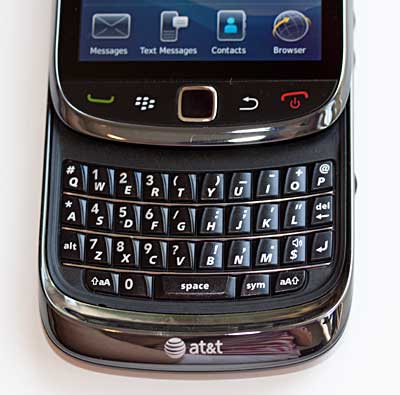 | 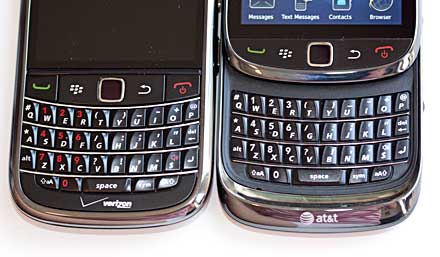 The Bold 9650 and the BlackBerry 9800. |
Video Review
Here's our video review of the BlackBerry Torch 9800 where we compare it with other smartphones, test out the new Webkit web browser, play local and YouTube video and demo OS 6.0's user interface.
Phone and Data
It's ironic that years ago BlackBerries made such poor phones that folks carried a BlackBerry for messaging and a feature phone for calls. These days BlackBerry smartphones tend to be much more phone-centric than competing smartphones running iOS, Android and even webOS. The dedicated call send and end keys, smart dialing, easy conference calling, a solid speakerphone, speed dial and voice dialing all conspire together to yield a wonderful calling experience. And as tends to be the case with high end GSM BlackBerry models, reception and call clarity are top notch. If you do a lot of calling, the BlackBerry 9800 beats the pants off of the iPhone 4 and Samsung Captivate. Reception is strong with the Torch getting significantly more signal (as measured in -db rather than bars). In the same locations, the Torch typically got a -20 db stronger signal than my Captivate and iPhone 3GS, and that's a big difference in reception. Call quality was extremely clear on both ends, and call recipients commented on how good I sounded, though my voice lost some clarity when the DSP kicked in when calling from noisy environments like big box store.

The Torch has a large and easy to use on-screen dialer with shortcuts to call history and contacts.
The usual BlackBerry push email experience is alive and well, with support for HTML email. Unlike the iPhone and Android phones, rich text email messages with attached pictures don't automatically load the image, you must select it for download. Bummer, but we assume RIM does this for security to avoid malware attachments and tracking by spammers. The Torch worked very well with Gmail and using the Google Sync plugin for BlackBerry, I had no trouble keeping contacts and calendar entries in sync. The Torch can also sync with Outlook on the desktop using the new BlackBerry 6 desktop software (the app can even sync music over WiFi). The phone works with POP3 and IMAP email, BIS (BlackBerry email service that's hosted by your carrier) and BES (BlackBerry Enterprise Server hosted by your company). The phone will not sync Exchange calendar and contacts items using Exchange ActiveSync, you'll need BES (if your company uses it) or you'll have to sync using the desktop software.
The big news for BlackBerry OS 6.0 is the Webkit web browser that replaces the atrocity that was the BlackBerry browser. It works in a similar fashion to the iPhone, Android and webOS browsers and it does an excellent job of rendering full HTML sites with layout intact. Javascript works fine (it killed the old BB browser) but there's no Flash support. The browser isn't quite as quick as the faster iPhone 4 and 1GHz Android superphones, but it's still a pleasure to use and I no longer feel like I have to carry a second phone just to browse the web. The phone comes with a YouTube player that plays mobile format YouTube videos with similar performance to the iPhone 4.
BlackBerry OS 6.0 and Performance
The Torch runs on a 624MHz XScale CPU that doesn't look good on paper compared to the top smartphones on the market with their 1GHz CPUs and graphics acceleration in some cases. A streamlined OS doesn't necessarily need a top dog CPU (that's Apple's argument for their computer line vs. Windows machines), but OS 6 does a lot and the Torch sometimes slows down for a second or two to think. As we mentioned, photo zooming 1 meg JPEG files could be faster as could pinch zooming in the browser. The Torch isn't a slow phone, it's just not as chronically peppy as the iPhone 4 and Samsung Captivate. We hope RIM ups the CPU speed in their next flagship model, if battery life can be preserved. The Torch 9800 has 512 megs of RAM (no complaints there and we didn't run into low memory issues) and 4 gigs of internal storage complimented by a 4 gig microSD card slot that's pre-installed (the slot is under the back cover near the SIM card slot and is hot swappable).
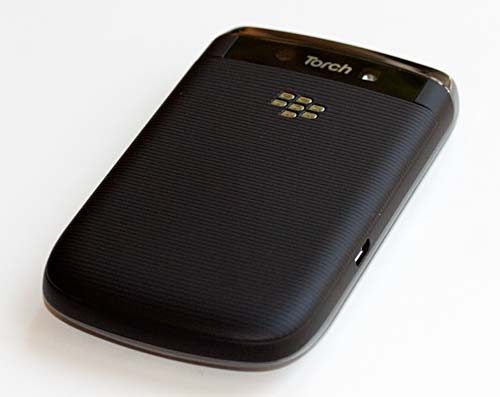
The OS improvements are many, though most of them deal with the user interface. RIM has done a fantastic job of revamping the UI into something that's thoroughly modern, enjoyable and efficient. It's extremely consistent (much more so than Android), yet it has more options than iOS. You can tap and hold to bring up additional functions, use the mouse cursor via the d-pad to select text for copy/paste as with Berries of old, count on the BlackBerry menu key to bring up a list of all possible functions in an application and switch between multi-tasking applications by holding down the menu key for a few seconds. The home screen offers quick and timely access to Twitter, Facebook, email, BBM, calendar items, podcasts and RSS feeds. Universal search is awesome, thorough and fast. It did a better job than our Droid X and Captivate at finding every local instance of a search term nearly instantly (admittedly, Google's search focuses more on Google web searches). Watch our video review to see the new UI and features in action.
The app story isn't nearly so rosy. RIM has yet to counter the iTunes store and the Android Market in terms of available applications. BlackBerry App World is easy enough to use, but with under 10,000 apps, and with apps sometimes being more expensive compared to those on the competing platforms, this is no software junky's phone. As a consolation, the most popular apps are available on all platforms, including BlackBerry. If you want Flixster, The Weather Channel, AP News, Kindle and Google Maps, they're available. AT&T has put their own app store on the phone, but while there are a few decent apps, many are generic Java games and the like.
Speaking of AT&T, their usual bloatware is here along with the good stuff like AT&T Navigator. Mobile Banking, Where, Yellow Pages Mobile, AT&T Maps and other assorted junk are on board, though at least the BlackBerry OS lets you hide icons for unwanted applications.
Camera and GPS
The BlackBerry Torch has a 5 megapixel camera with autofocus lens and a bright LED flash that can illuminate subjects in a dark room. It takes sharp photos with good color saturation. Still photos are on par with the 5 megapixel Captivate, and lag behind the iPhone 4 only for bright sunlight shots where the Torch is prone to modest whiteout. The camera focuses quickly: simply press the side convenience key half way to focus, then all the way to take a shot in single shot focus mode. We suggest you change the default continuous auto-focus to single shot focus for sharper shots. There are plenty of photo options and the photo viewer is quite capable. The phone can shoot VGA video at 24-30fps. Video looks quite good, but in terms of specs, it's not as impressive as the HD capture available on other high end smartphones. That said, quality counts more than pixel quantity and the 9800 takes sharp video. There's an option to direct upload videos to YouTube as well.

The 9800 has a built in GPS and it ships with AT&T Navigator (powered by TeleNav) and the less useful AT&T Maps. Navigator provides spoken turn-by-turn directions, POIs, traffic information and more. It's a solid application that provides reliable directions and it costs $10/month (you can add and remove it from your account at any time). AT&T Maps does not provide spoken navigation but it's free. Honestly, Google Maps is better if you're looking for a free solution. The GPS had no problem getting and maintaining a fix in our tests, and the speakerphone, though not as stellar as the Bold 9000's, was loud and clear enough for in-car directions.
Battery Life
The BlackBerry Torch has a 1270 mAh Lithium Ion battery that's user replaceable. RIM places great importance on battery life, and we assume that's the reason they didn't go with an even faster CPU on the Torch. We found that the Torch had no problem lasting through the day with heavy use, and it managed two days with light use. If you use the GPS for long road trips, expect shorter runtimes. While the Torch doesn't last as long as the Bold 9700, it does outlast the Captivate, EVO and Storm 2.
Conclusion
The BlackBerry Torch is undeniably the best BlackBerry yet. RIM has managed to keep it familiar, yet fresh, to paraphrase their CEO. That should be good enough to hold onto existing BlackBerry users (and there are a lot of you), but we doubt they'll steal many iPhone and Android customers. The philosophy and features simply don't align: the iPhone and Android are fun phones first, and are still undeniably more entertaining and consumer oriented than the Torch. If you want a large touch screen, lots of downloadable apps and games and are less concerned with calling features, push email and security, then we doubt the Torch will win you over. If you want a capable smartphone with a touchscreen, modern webkit browser, a hardware keyboard and excellent calling, messaging and notification features, the Torch beckons. It's good to have choices, and we're glad to see RIM offer an updated and more competitive product.
Price: $199 with a 2 year contract, $499 without contract extension (AT&T)
Specs:
| Display: 3.2" capacitive multi-touch display. Resolution: 360 x 480, supports both portrait and landscape modes via accelerometer. Has proximity sensor. Battery: Lithium Ion rechargeable. Battery is user replaceable. 1270 mAh. Performance: XScale 624 MHz processor. 512 MB built-in RAM. 4 gigs flash storage. Size: 4.47 x 2.78 x 0.53 inches. Weight: 5.3 ounces. Phone: GSM quad band world phone with EDGE 850/900/1800/1900MHz. 3G HSDPA on AT&T's 850/1900MHz bands and 2100MHz for overseas. Camera: 5.0 MP with autofocus lens and LED flash. Can shoot video up to VGA resolution at 30fps (had direct upload to YouTube feature). Audio: Built in speaker, mic and 3.5mm standard stereo headphone jack. Networking: Integrated WiFi 802.11b/g/n and Bluetooth. Software: BlackBerry OS 6.0. Expansion: 1 SDHC microSD card slot, a 4 gig card is included. Micro USB port for sync and charge. |
Subscribe to:
Comments (Atom)







